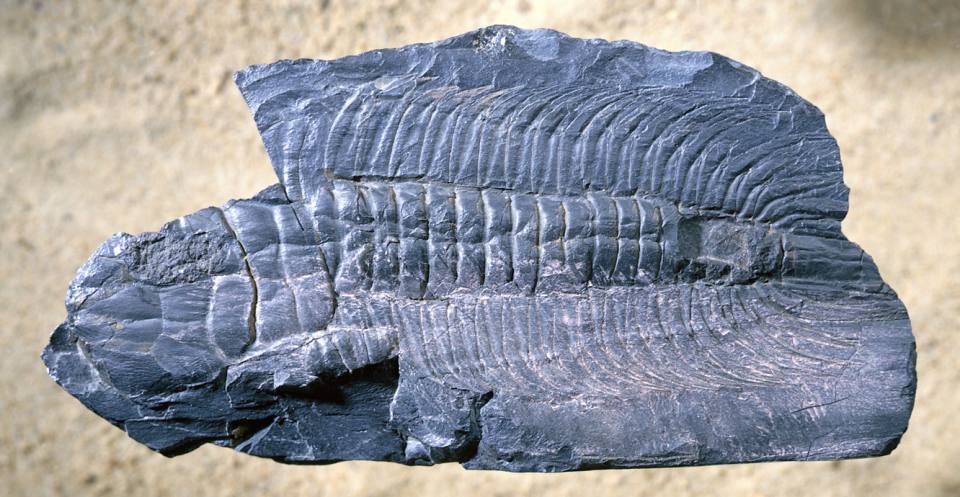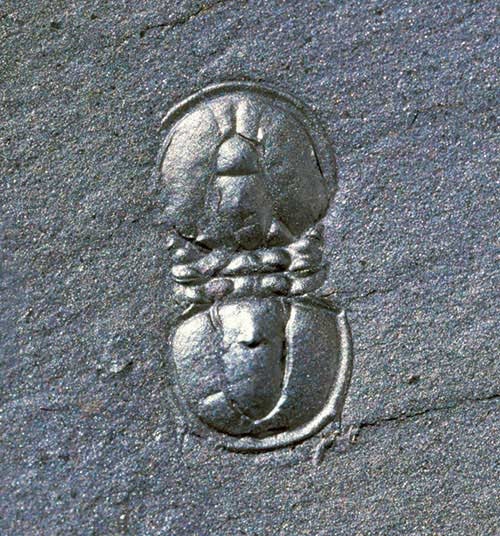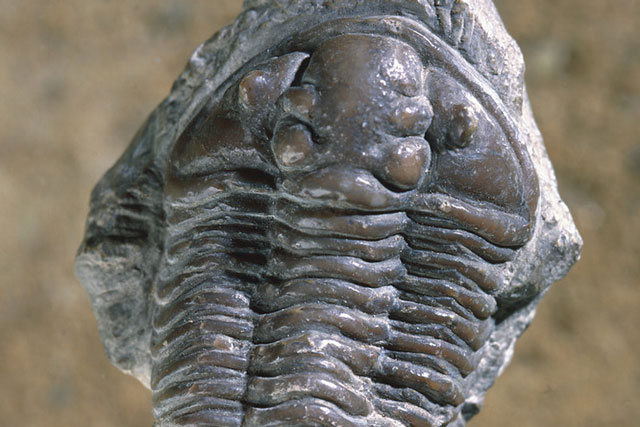Trilobites rank among the most important early animals. Our knowledge of them has been gained from the study of their fossils, usually the impressions left of their shells after burial in sediment that subsequently hardened into rock.
They appeared abruptly in the early part of the Cambrian Period and came to dominate the Cambrian and early Ordovician seas. A prolonged decline then set in before they finally became extinct at the end of the Permian Period, about 250 million years ago.
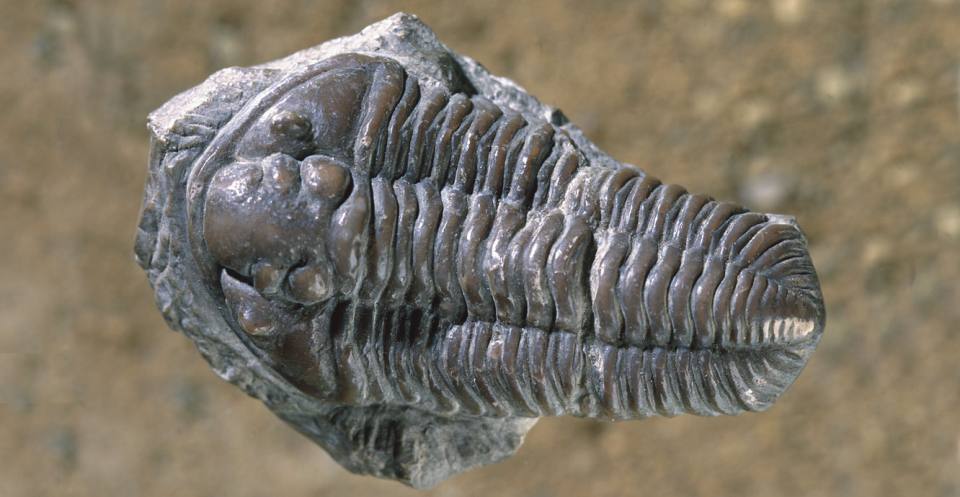
Calymene blumenbachii, Silurian, England, became known as the Dudley Locust, Dudley Bug or Dudley Insect. Calymene is featured at the centre of Dudley’s Coat of Arms. BGS © UKRI.
The animal
Like many invertebrate animals living today, including crustaceans, spiders and insects, trilobites were arthropods, belonging to the phylum Arthropoda. Geologists know that they were marine animals because of the rocks in which they are found and the other types of fossils associated with them.
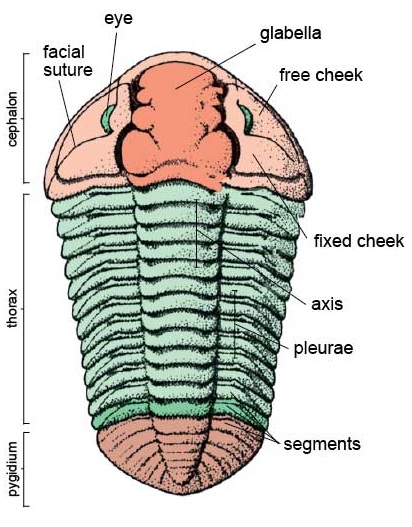
Parts of a trilobite exoskeleton. BGS © UKRI.
For support and protection, the soft parts of the animal were covered by an exoskeleton. Usually only the dorsal part of the exoskeleton, covering the animal’s back, was fossilised. The ventral (underside) part of the animal may have been covered by a soft membrane or other material that could not be fossilised.
The exoskeleton is divided from anterior (front) to posterior (back) into:
- cephalon (head-shield)
- thorax
- pygidium (tail-shield)
It is also divided from side-to-side into a central axis, with two side regions (lobes) called pleurae. The word ‘trilobite’ refers to this side-to-side partition, rather than the cephalon, thorax and pygidium.
The cephalon, thorax and pygidium are all divided into segments. In life, the segments of the cephalon and pygidium were fused, but those of the thorax were not, enabling the animal to roll into a ball to protect its relatively vulnerable ventral side in times of danger.
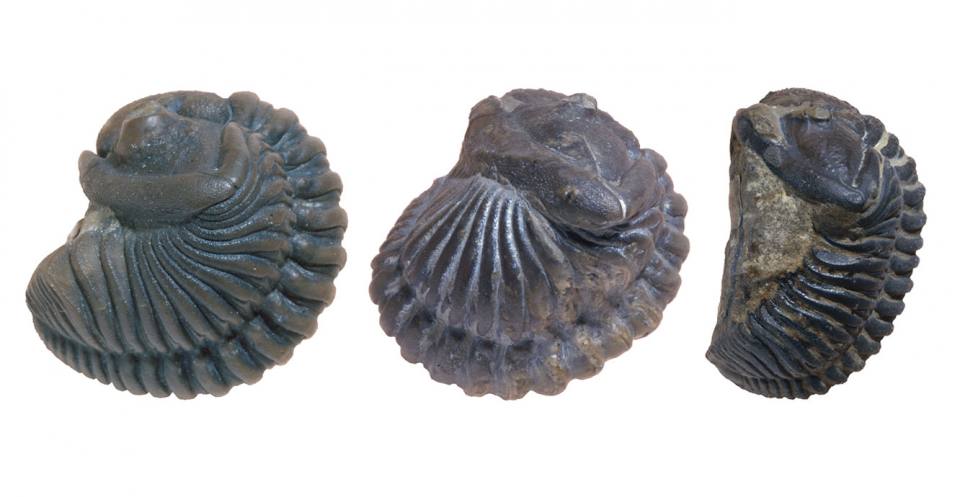
Specimens of Calymene from the Silurian Period. Calymene was able to roll into a ball for protection. BGS © UKRI.
The central region of the cephalon is termed the glabella. The cheeks on either side of the glabella are usually traversed by a facial suture that separates them into fixed cheeks (adjoining the glabella) and free cheeks on the outer edge of the cephalon. The suture helped the animal to moult during growth. When moulting, the trilobite’s cast-off exoskeleton often fell to pieces, so their fossilised remains are usually found as fragments.
Eyes and other sensory organs
Most trilobites had eyes, although blind forms are known. The eyes are situated on the inner edge of the free cheek, adjacent to the fixed cheek.
Trilobites had compound eyes, consisting of a number of separate lenses. The number of lenses and the complexity of the eye structure varied enormously. Some trilobites had large, convex compound eyes (like a fly’s) with a large number of lenses, giving them a wide field of view forwards, backwards, sideways, upwards and even downwards, depending on the actual curvature of the eye. Other trilobites had much smaller eyes, with fewer lenses, giving them a more restricted view.
Many trilobite eyes consisted simply of closely packed prisms of calcite, but in some later forms, for example the Silurian–Devonian genus Phacops, the eyes had more complex lenses. Using these, Phacops may have been able to see an object clearly and even estimate how far away it was.
Other sensory organs possessed by trilobites included pits, canals, tubercles and spines on the surface of the exoskeleton.
Soft parts
Soft parts, preserved under special circumstances in sedimentary deposits known as Lagerstätten (singular Lagerstätte), are known for a few trilobite species. From these, geologists know that trilobites had a pair of jointed antennae protruding forwards from beneath the cephalon and rows of jointed limbs on each side of the body.
There were three pairs of limbs beneath the cephalon and a single pair of limbs beneath each segment of the thorax and pygidium. Each limb had two branches: a lower branch used for walking and an upper branch bearing a large number of fine filaments, which may have been used for respiration.
Environment
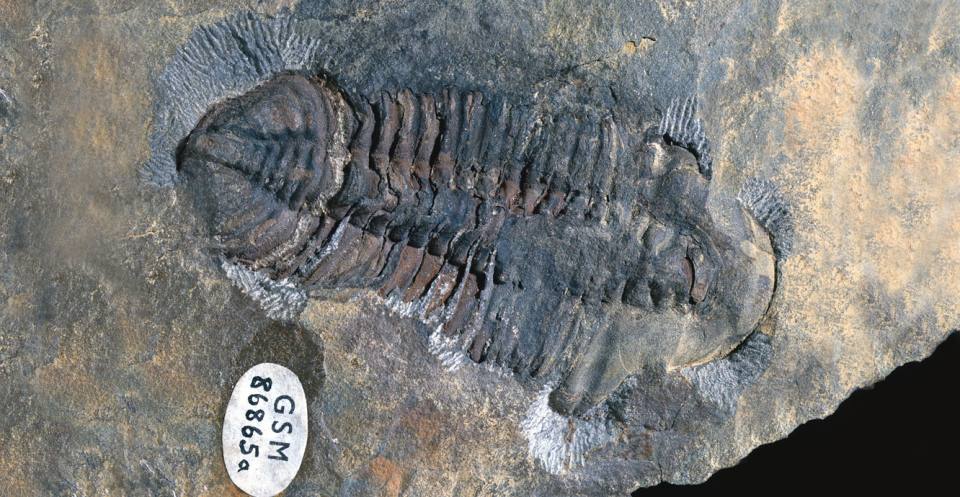
Neseuretus, Ordovician, Shropshire, England (× 0.6). BGS © UKRI.
There is some evidence that particular trilobites lived at certain depths in the sea, so they can be used as indicators of palaeoenvironment. Neseuretus is an example of a genus that is associated with very shallow water deposits, whereas trinucleid trilobites, such as Whittardolithus, are thought to have lived on a deep sea bottom.
The great variety of body shapes and sizes indicate that trilobites occupied a variety of ecological niches. Blind trilobites may have burrowed and scavenged in mud on the sea floor, or lived at great depth in the sea where there was no light. Other trilobites are associated with trails on bedding planes (e.g. Cruziana), which show that they moved about on the sea-floor, perhaps scavenging or preying on other animals. These trilobites were part of the benthos (sea floor dwelling lifeforms). Yet more trilobites, such as Cyclopyge, had large eyes that enabled them to see downwards as well as in other directions. This, together with their widespread distribution, has led geologists to think that they swam or floated above the sea floor.
Many trilobites were 3–6 cm long, but some such as Paradoxides were giants, up to 60 cm or more, while others like the tiny, blind agnostid trilobites were no more than a few millimetres long.
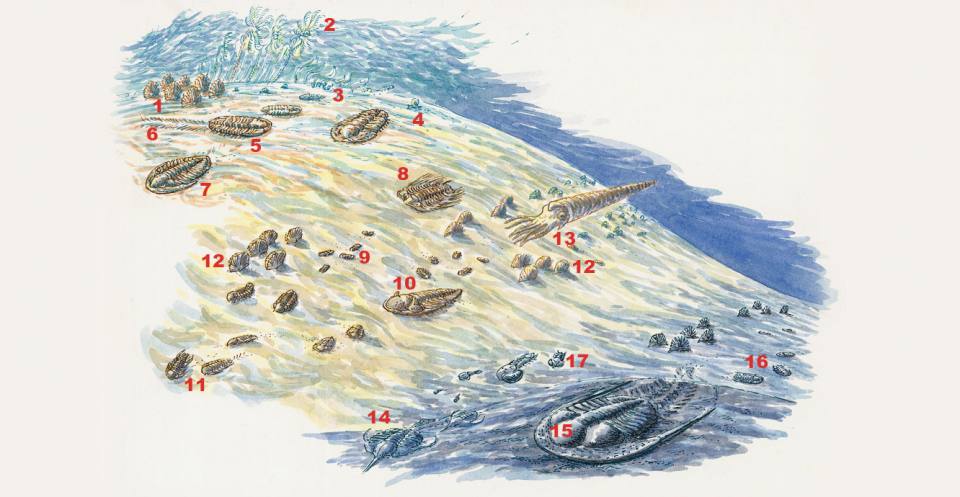
Lifestyles of trilobites: the painting shows how trilobites from different periods lived in the sea. In shallow waters amongst the bivalves (1), crinoids (2), algae (3) and gastropods (4), the faunas were large, but of low diversity, e.g. Flexicalymene (5). Intermediate faunas were more diverse: Selenopeltis (8), Geragnostus (9), Chasmops (10) and Remopleurides (11) lived alongside brachiopods (12) and nautiloids (13). In the depths of the sea, the trilobites were small and blind with moderate diversity— Ampyx (14), Tretaspis (15) and Shumardia (16), with Pricyclopyge (17) swimming above. Richard Bell, BGS © UKRI.
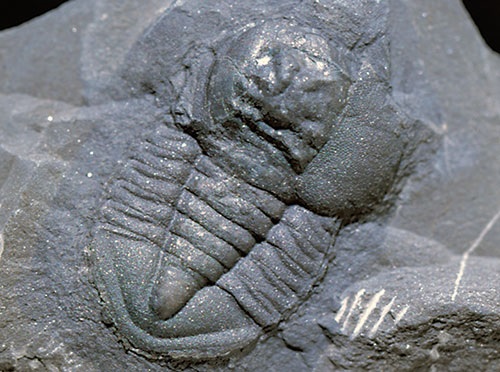
Pricyclopyge, a trilobite with large eyes and all-round vision which probably swam rather than crawling on the sea floor. (× 2.5). BGS © UKRI.
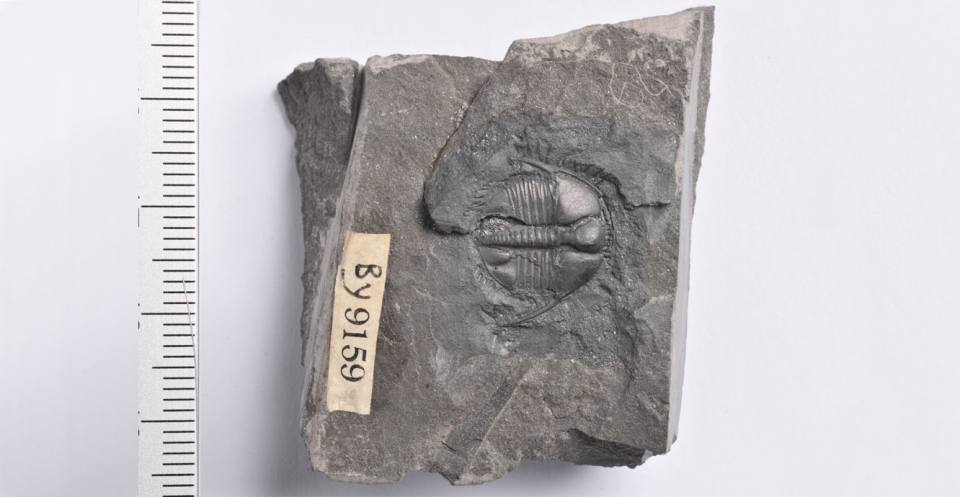
Trinucleus, a trilobite with no eyes, which lived in mud or at great depths. It had spines for support, and a fringe with pits, possibly for sensory organs (× 3). BGS © UKRI.
The geologists’ tool
Trilobites appeared in the Cambrian Period and became extinct at the end of the Permian Period. In Britain, trilobites occur in rocks of Cambrian, Ordovician and Silurian age, for example in Wales and the Welsh Borderland, in Devonian rocks of south-west England and in Carboniferous rocks, for example in Lancashire.
Geologists use trilobites in a variety of ways to help them understand how the Earth has developed. One use is in the relative dating and stratigraphical correlation of sedimentary rock successions, especially in rocks of Cambrian and early Ordovician age. Trilobites are particularly important for correlating Cambrian rocks. Paradoxides, for example, occurs in rocks in England, Wales, Newfoundland, Sweden, Spain and Siberia, and shows that these rocks are all of the same, middle Cambrian age. Other stratigraphically useful trilobites include species of Merlinia in the early Ordovician and Calymene in the Silurian.
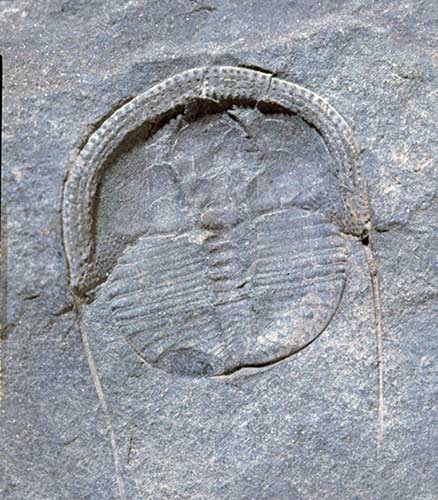
Whittardolithus (× 1.5). BGS © UKRI.
Another use of trilobites in geology is in reconstructing past geographies (palaeogeography) and past environments (palaeoenvironments). The early Ordovician trilobite Petigurus is found in north-west Scotland but nowhere else in Britain, although it can be found in North America. Early Ordovician trilobites from England and Wales (e.g. Placoparia) are unlike those from North America, but are also found in France, Spain, Portugal, Bohemia and North Africa. This is part of the evidence showing that much of Scotland was close to North America about 500 million years ago and was separated from southern Britain by an ocean that has been named Iapetus.
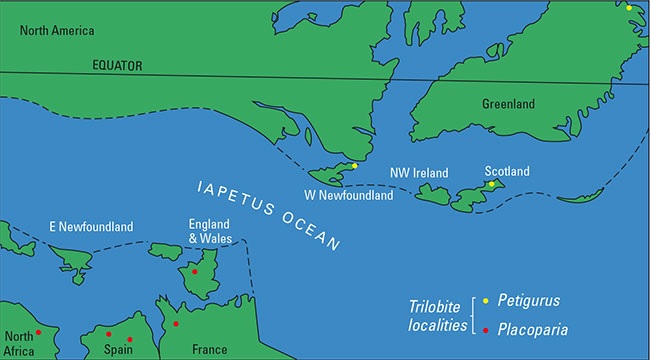
A continental reconstruction for around 500 million years ago using today’s geographical land outlines. The Iapetus Ocean, which separates the ‘trilobite provinces’, closed in the Silurian and the resulting collision between North America and Europe produced the Caledonian mountains. BGS © UKRI.
Fun facts

In south Wales, around Carmarthen, the tails (pygidia) of some early Ordovician trilobites are so conspicuous that they were referred to locally as ‘petrified butterflies’ and were associated with legends concerning the magician Merlin. BGS © UKRI.
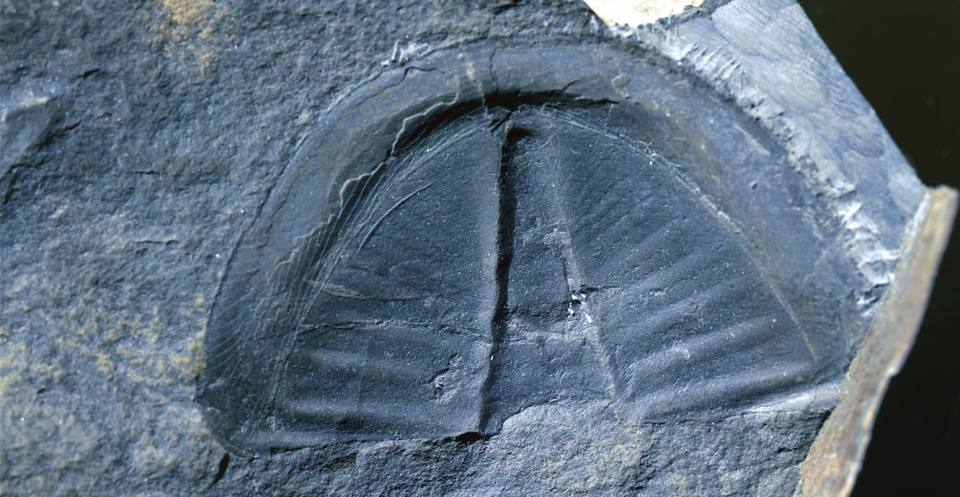
Merlin the magician even has a trilobite from this area named after him — Merlinia. Elsewhere, there are associations between trilobite tails and butterflies or bats, for example in the Swedish fjärilssten and the Chinese Hu-die-shih, both meaning butterfly stone, and the Chinese Bien-fu-shih, meaning bat stone. BGS © UKRI.
3D fossil models
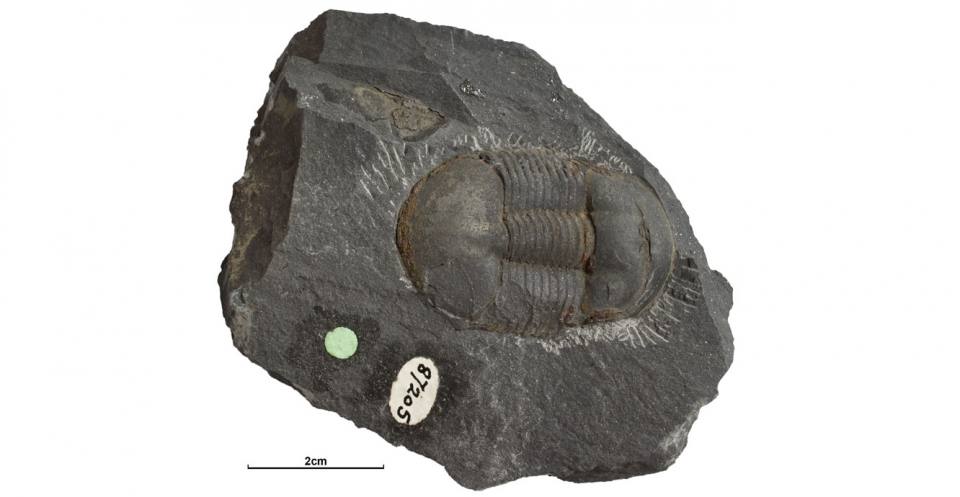
Ectillaenus bergaminus Whittard. (Ordovician, Arenig.) See 3D fossils online. GB3D Type Fossils. BGS © UKRI.
Many of the fossils in the BGS palaeontology collections are available to view and download as 3D models. To view this fossil, or others like it, in 3D visit GB3D Type Fossils.
Reference
Molyneux, S G. 1999. Trilobites: fossil focus. (Nottingham, UK: British Geological Survey.)
You may also be interested in

Discovering Geology
Discovering Geology introduces a range of geoscience topics to school-age students and learners of all ages.
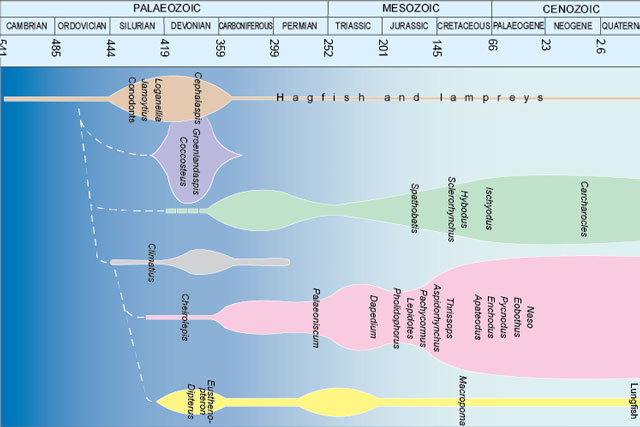
Fossils and geological time
Take a look at the history of the Earth, from its formation over four and a half billion years ago to present times.




